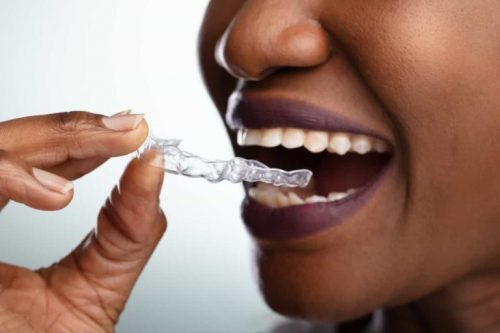The Science Behind Invisalign: How Do Clear Aligners Work?
Invisalign has transformed the way people think about teeth straightening. These nearly invisible aligners offer a discreet and comfortable alternative to traditional braces. But what makes them so effective? Understanding the science behind Invisalign sheds light on how clear aligners gradually improve smiles.
What Are Invisalign Aligners?
Invisalign aligners are custom-made, removable trays made from a specialized plastic material. They fit snugly over the teeth and apply controlled force to guide them into the desired position. Unlike metal braces, they are transparent and can be removed for eating, brushing, and flossing.
The Material That Sets Invisalign Apart
The aligners are made from SmartTrack, a patented thermoplastic material. SmartTrack provides flexibility, durability, and consistent pressure. It ensures the aligners fit comfortably while maintaining the precise movements needed to shift teeth.
How Does Invisalign Work?
Invisalign relies on advanced digital technology and biomechanics to straighten teeth. The process begins with a thorough consultation and moves into a detailed treatment plan designed just for you.
Step 1: Digital Scanning and Treatment Planning
Dentists or orthodontists use a 3D scanner to create an accurate digital model of your teeth. This replaces traditional impressions and allows for a more detailed analysis. Using software, the provider maps out the exact movements needed to align your teeth. The treatment plan includes a series of virtual stages, showing how your smile will transform over time.
Step 2: Custom Aligners
Once the treatment plan is ready, a series of aligners is created. Each set is slightly different, designed to move your teeth in small increments. You’ll wear each aligner for one to two weeks before switching to the next.
Step 3: Gradual Tooth Movement
The aligners apply gentle pressure to specific teeth, encouraging movement. This pressure is carefully controlled to prevent discomfort and ensure efficiency. Over time, this process realigns your teeth to their ideal positions.
The Science of Tooth Movement
Teeth move because of a biological process known as bone remodeling. When pressure is applied to a tooth, the bone surrounding it responds by breaking down on one side and rebuilding on the other. Invisalign aligners leverage this process by applying consistent, low-force pressure in targeted areas.
Role of Pressure Points
Unlike braces, Invisalign aligners don’t pull teeth with wires and brackets. Instead, they use pressure points built into the aligners. These points direct force precisely where it’s needed, improving control over the movement.
Benefits of Invisalign’s Approach
Invisalign’s design and technology offer several advantages that go beyond aesthetics. Here’s why it stands out:
Predictable Results
The digital planning process ensures precise tooth movement. Patients and providers can see the expected results before treatment begins, making the outcome more predictable.
Comfort
The smooth, plastic aligners are gentler on gums and cheeks compared to metal braces. Their design eliminates sharp edges and reduces the risk of irritation.
Convenience
Invisalign aligners are removable, allowing you to eat your favorite foods and maintain better oral hygiene during treatment.
Shorter Adjustments
Unlike braces, Invisalign requires fewer office visits for adjustments. Most appointments involve checking progress and providing new sets of aligners.
Invisalign Attachments and Accessories
Some cases require extra tools to achieve the desired outcome. These include:
- Attachments: Small tooth-colored bumps added to specific teeth. They help the aligners grip teeth better and improve control over movements.
- Rubber Bands: Used in certain cases to correct bite issues by adding additional force.
- Refinements: Extra aligners made to address any adjustments needed at the end of the initial treatment.
Who Can Benefit from Invisalign?
Invisalign treats a wide range of dental issues, including:
- Crooked or misaligned teeth
- Gaps between teeth
- Overbites, underbites, and crossbites
- Crowded teeth
It’s suitable for teens and adults, though severe cases may still require traditional braces.
Caring for Invisalign Aligners
Proper care ensures your aligners stay effective and maintain their clarity. Here are some tips:
- Clean them daily with a soft toothbrush and mild soap.
- Avoid eating or drinking anything other than water while wearing them.
- Store them in their case when not in use to prevent loss or damage.
The Role of Compliance in Invisalign Success
Invisalign requires commitment to wearing the aligners for 20–22 hours daily. Removing them for too long can delay progress. Following the recommended schedule ensures each aligner does its job before moving to the next.
Comparing Invisalign to Traditional Braces
While both options effectively straighten teeth, Invisalign provides clear advantages in terms of comfort, aesthetics, and convenience. However, traditional braces may be better for extremely complex cases.
Is Invisalign Right for You?
The best way to find out is through a consultation with your dentist or orthodontist. They’ll assess your needs and recommend the most effective treatment.
Invisalign combines cutting-edge technology and advanced materials to deliver customized, predictable results. Its discreet, comfortable approach makes it a popular choice for improving smiles while maintaining daily life routines.
Conclusion
Invisalign has redefined how teeth straightening is approached, offering a modern, comfortable, and effective alternative to traditional braces. Its use of advanced digital planning, precise aligner design, and controlled force ensures gradual and predictable tooth movement. The ability to customize treatment, combined with benefits like comfort and convenience, makes it a preferred choice for many individuals.




